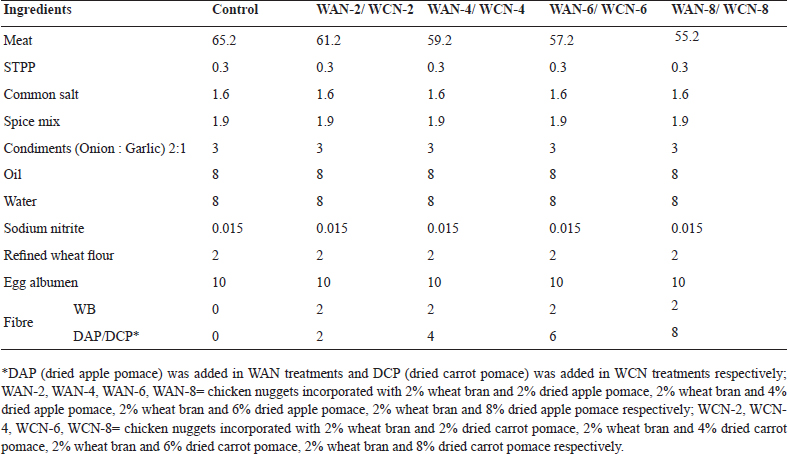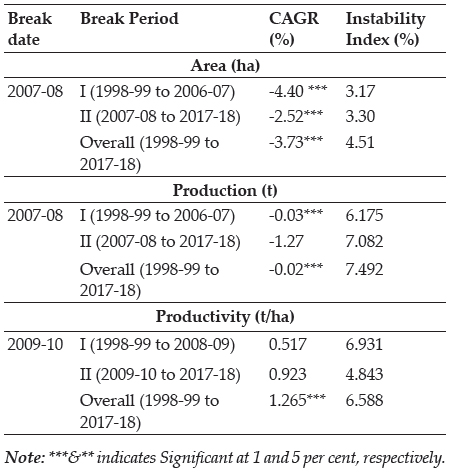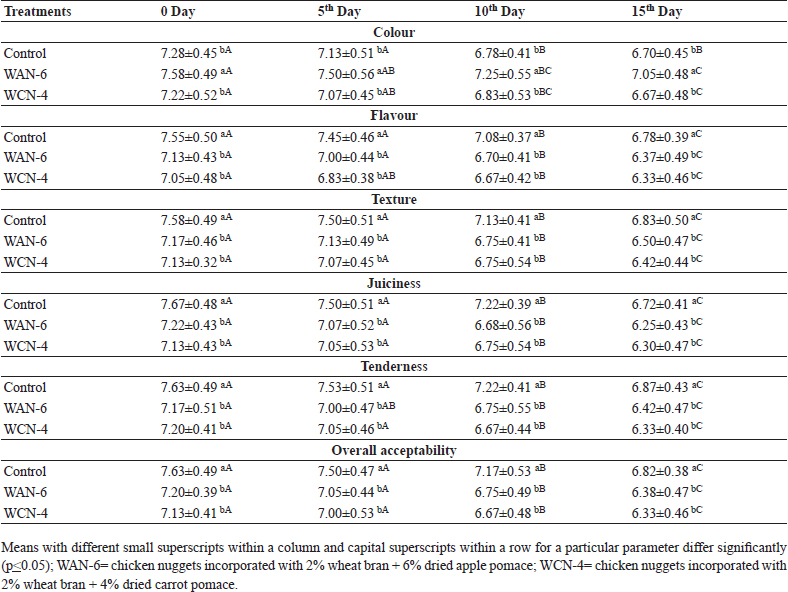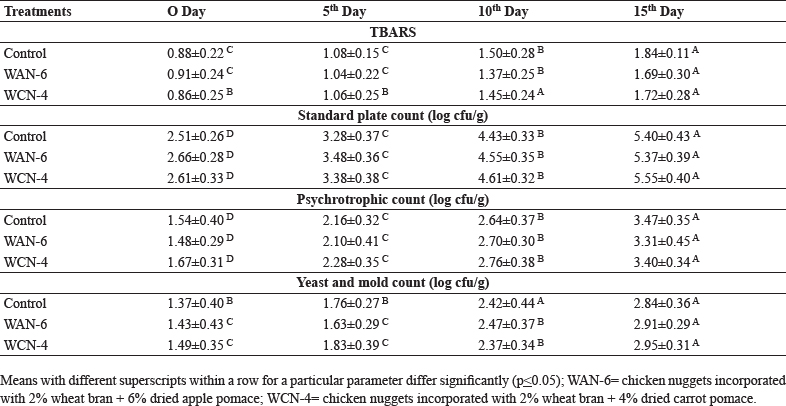
Journal of Animal Research: v.10 n.1, p. 95-103. February 2020
DOI: 10.30954/2277-940X.01.2020.13
Development of Fibre Enriched Chicken Nuggets Using Combination of WheatBran with Dried Apple Pomace or Dried Carrot Pomace
ABSTRACT
This investigation was conducted to evaluate the effect of incorporation of wheat bran (WB) with dried apple pomace (DAP) or dried carrot pomace (DCP) on quality attributes of chicken nuggets. Raw emulsion was stuffed in rectangular moulds, cooked in electric oven at 165°C for 40 minutes and nuggets were prepared by slicing cooked emulsion to 2-3 cm3 size. Colour scores increased with increase in DAP level in WB + DAP treated nuggets. A steady decrease in scores for all other sensory attributes was noticed in both WB + DAP and WB + DCP treated nuggets with increase in fibre level. Hardness and shear press value increased whereas springiness and cohesiveness decreased with increase in fibre level. Gumminess and chewiness of WB + DAP treated nuggets increased with increase in fibre level while gumminess and chewiness of WB + DAP treated nuggets showed a variable trend. Cooking yield and emulsion stability of fibre enriched nuggets were significantly higher whereas moisture, protein, cholesterol content and pH were significantly lower than control. Insoluble, soluble and total dietary fibre content increased drastically in treated nuggets. Thiobarbituric acid reacting substance (TBARS) value and microbial counts increased significantly during refrigerated storage in all the products. It is concluded that healthier and dietary fibre enriched chicken nuggets with refrigerated storage stability up to 15 days can be prepared using combination of wheat bran (2%) with dried apple pomace (6%) or dried carrot pomace (4%) each.
Keywords: Apple pomace, carrot pomace, chicken nuggets, total dietary fibre, wheat bran
Dietary fibre has received enough positive consideration in recent times as a possible pharmafood because of its ability to diminish cholesterol, diabetes and coronary heart disease and reduce constipation (Telrandhe et al., 2012). Dietary fibre provides technological functions like water binding and retention resulting in reduction in cooking loss and minimizing shrinkage and drip loss during storage. Dietary fibre reduces production cost and balances undesirable alteration in texture due to formulation changes without affecting sensory quality of final product (Biswas et al., 2011; Henning et al., 2016). Hence, incorporation of dietary fibres in meat products help to improve their functionality and desirability in addition to health benefits.
Wheat bran is an economical and rich source of dietary fibre. It comprises of about 53% dietary fibre consisting of xylans, lignin, cellulose, galactan and fructans. It also contains vitamins, minerals and bioactive compounds such as alkylresorcinols, ferulic acid, flavonoids, carotenoids, lignans and sterols (Apprich et al., 2013; De Brier et al., 2014).
Fibre from fruit and vegetable sources has better water and oil binding ability, colonic fermentability and lesser phytic acid content and energy (Biswas et al., 2011). As producers are persistently searching for more affordable ingredients with an added value, the byproducts of fruit and vegetable processing present a possible solution. Extensive research has revealed fruit and vegetable by-products to be a high source of dietary fibre. Apple pomace is a byproduct of apple juice industry. It is a rich source of carbohydrate, pectin, crude fibre and minerals (Shalini and Gupta, 2010). Thousands of tons of carrot pomace are produced after extraction of juice from carrot. Carrot pomace is a rich source of fibre and beta carotene which is a bioactive compound (Nagarajaiah et al., 2015).
How to cite this article: Yadav, S., Pathera, A.K., Malik, A. and Sharma, D.P. (2020). Development of fibre enriched chicken nuggets using combination of wheat bran with dried apple pomace or dried carrot pomace. J. Anim. Res., 10 (1): 95-103.
The processing of meat products by incorporating dietary fibre sources like brans and pomace leads to generation of fibre enriched functional meat products that are beneficial to human health. Previously, dietary fibre enriched chicken sausages with higher cooking yield and emulsion stability were prepared in our laboratory by incorporating wheat bran, dried carrot pomace (Yadav et al., 2018) and dried apple pomace (Yadav et al., 2016) individually to chicken meat. This study was carried out to investigate the combined effect of wheat bran with dried apple pomace or dried carrot pomace on quality characteristics of chicken nuggets.
MATERIALS AND METHODS
Procurement and processing of dietary fibre sources
Wheat bran, apple and carrot were purchased from local market. Apple and carrot pomace were obtained after extraction of juice. Wheat bran and both types of pomace were separately dried, ground, packaged in air tight container and stored under frozen conditions (Yadav et al., 2016; 2018).
Preparation of chicken nuggets
Meat was manually deboned and minced in an electrical mincer with 4 mm plate. Additives like sodium chloride, spice mix, condiments paste, sodium nitrite, sodium tripolyphosphate (STPP), refined wheat flour, groundnut oil, egg albumen and water were added to minced meat in suitable proportion (Table 1) for the manufacturing of control meat emulsion.
Table 1: Composition of meat emulsion for preparation of chicken nuggets

Treatments of wheat bran (WB) and dried apple pomace (DAP) consisted of addition of 2% WB + 2% DAP (WAN- 2), 2% WB + 4% DAP (WAN-4), 2% WB + 6% DAP (WAN-6), 2% WB + 8% DAP (WAN-8) respectively by replacing lean meat. Treatments of WB and dried carrot pomace (DCP) consisted of addition of 2% WB + 2% DCP (WCN-2), 2% WB + 4% DCP (WCN-4), 2% WB + 6% DCP (WCN-6), 2% WB + 8% DCP (WCN-8) respectively by replacing lean meat (Table 1). The additives other than dietary fibre sources were used in same concentration as in control. A fine meat emulsion was prepared by mixing minced chicken meat and other ingredients (including dietary fibres) in a bowl chopper for 4 to 6 min. The raw emulsion so prepared was stuffed in rectangular moulds and baked in electric oven at 165°C for 40 minutes. Cooked emulsion was cooled to room temperature. Nuggets were prepared by slicing cooked emulsion to 2-3 cm3 size, packaged in polythene bags and stored at refrigerated temperature for further study. One treatment each from WB + DAP and WB + DCP treatments was selected on the basis of sensory evaluation. Selected treatments were subjected to physicochemical and nutritional analysis and shelf life was determined under refrigerated (4±1°C) condition.
Analysis
Proximate and physicochemical analysis
Proximate composition (moisture, fat, protein and ash content) of chicken nuggets was analyzed by following the standard method of AOAC (1995). Standard procedures were used to determine pH (Trout et al., 1992), emulsion stability (Baliga and Madaiah, 1970), thiobarbituric acid reacting substances (TBARS) value (Witte et al., 1970). Cooking yield was measured by recording the weight of the cooked product and initial raw weight and expressed as a percentage. A combination of enzymatic and gravimetric method (AOAC, 1997) by utilizing TDF assay kit (Sigma- Aldrich Inc.) was used for estimating soluble dietary fibre (SDF), insoluble dietary fibre (IDF) and total dietary fibre (TDF) content. For cholesterol estimation, the total lipids from a sample were extracted as per the method of Angelo et al. (1987) with a little alteration. The total cholesterol content in the lipid extract was measured by following the spectrophotometric method of Zak (1957).
Texture profile, shear press and instrumental colour analysis
The texture profile of chicken nuggets was analyzed using TAHD Plus Texture Analyser (Stable Micro Systems, England) by following the method of Bourne (1978). A compression platform of 70 mm diameter was used as a probe. Samples of 2 cm3 size were compressed (by 50 kg load cell and the test speed of 2mm/s) to 50% of their initial height. A 5 sec time interval was given between two compression cycles to obtain force time deformation curves. Warner Bratzler shear probe was used to determine shear press value. Force needed to shear 1 cm3 nugget sample transversely was expressed in Newton (N). The colour scores were measured as CIE Lab, L* (lightness), a* redness) and b* (yellowness) using a chroma meter (Konica Minolta Sensing, Inc., Japan) with 8 mm orifice for measurement.
Sensory evaluation
A semi-trained panel comprising of ten members was used for determining the sensory quality of nuggets. Sensory attributes (colour and appearance, flavour, texture, tenderness, juiciness and overall acceptability) were analyzed using 8-point descriptive scale where scores 8 and 1 indicated extremely desirable and extremely undesirable respectively.
Microbiological analysis
Standard plate count (SPC), psychrotrophic count (PC) and yeast and mold counts of chicken nuggets were estimated at regular intervals during refrigerated storage (APHA, 1984).
Statistical analysis
The data obtained were subjected to analysis of variance. For fresh nuggets, one-way analysis of variance and for refrigerated stored nuggets, two-way analysis of variance was performed. Duncan's multiple range test was used to find out the significant difference in means (Snedecor and Cochran, 1980).
RESULTS AND DISCUSSION
Sensory scores of fibre treated chicken nuggets
Sensory scores of chicken nuggets incorporated with combination of WB with DAP or DCP are presented in table 2. Colour and appearance scores increased with increase in level of DAP in nuggets. Significant increase was noticed in treatment WAN-6. Desirable effect of DAP on colour might be due to the presence of apple peel in DAP which provided desirable red colour to chicken nuggets. Incorporation of WB in combination with DCP resulted in a decrease in colour scores and significant decrease was noticed in treatment WCN-6. Flavour, texture, tenderness, juiciness and overall acceptability of treatments WAN- 2 and WCN-2 were comparable with control. Further increase in fibre level resulted in a decrease in scores of these sensory attributes in both WB + DAP and WB + DCP incorporated nuggets. Masking of meaty flavour due to WB, DAP or DCP might have contributed to lower flavour of fibre incorporated sausages. Mehta et al. (2013) also reported a decrease in sensory scores of chicken rolls and patties with increasing levels of rice bran and psyllium husk. However sensory scores of treatments WAN-6 containing 2% WB + 6% DAP and WCS-4 containing 2% WB + 4% DCP were around 7.0 meaning very good acceptability.
Table 2: Sensory scores of chicken nuggets incorporated with combination of wheat bran with dried apple pomace or dried carrot pomace (n=30, mean ± SD)

Table 3: Instrumental texture and colour properties of chicken nuggets incorporated with combination of wheat bran with dried apple pomace or dried carrot pomace (n = 6, mean ± SD)

Instrumental texture and colour analysis
Instrumental texture analysis revealed an increase in hardness after incorporation of dietary fibre and significant difference in comparison to control was noticed in treatments WAN-4 and WCN-2 (Table 3). Springiness and cohesiveness decreased in both types of nuggets. Significant decrease in springiness was noticed from treatments WAN-6 and WCN-2, whereas significant decrease in cohesiveness was noticed from treatments WAN-4 and WCN-4 in comparison to control. Effect of fibre incorporation on texture of nuggets was also noticed by sensory panellists as discussed earlier. Grossi et al.(2011) observed that addition of carrot dietary fibre in a comminuted meat emulsion results in a high order of network association contributing to a harder texture and high water binding capacity. Saricoban et al. (2009) also observed that incorporation of wheat bran to cooked beef patties increased their hardness and gumminess and decreased springiness and cohesiveness without influencing the adhesiveness. No significant difference was noticed in gumminess and chewiness scores up to treatment WAN-4 in WB+ DAP treated nuggets and significant increase in comparison to control was noticed in treatments WAN-6 and WAN-8. Gumminess and chewiness scores of WB + DCP treated nuggets showed a variable trend. Gumminess scores of treatments WCN-2, WCN-4 and WCN-8 were significantly higher than control while those of treatment WCN-6 were comparable with control. Chewiness scores of treatments WCN-4 were significantly higher than control while corresponding scores for other treatments were comparable with control. Gumminess and chewiness scores of a meat product depend on its hardness, cohesiveness and springiness scores. Shear press value of treatment WCN-2 was comparable with control and it increased significantly in all other treatments containing either WB + DAP or WB + DCP. No significant difference was noticed in colour attributes i.e. lightness (L*), redness (a*) and yellowness (b*) of control and WB+DAP treated nuggets. However a non significant decrease in lightness and increase in redness was noticed with increase in fibre level. Lightness and redness decreased non significantly in WB + DCP treated nuggets while yellowness scores increased and significant increase in comparison to control was noticed in treatment WCN-8. Increased yellowness of WB + DCP incorporated nuggets might be due to the presence of phytochemicals in carrot pomace which contributed yellow colour.
Table 4: Proximate composition and physico-chemical properties of chicken nuggets incorporated with combination of wheat bran with dried apple pomace or dried carrot pomace (n = 6, mean ± SD)

WAN-6= chicken nuggets incorporated with 2% wheat bran + 6% dried apple pomace; WCN-4= chicken nuggets incorporated with 2% wheat bran + 4% dried carrot pomace; Means with different superscripts within a row differ significantly (p<0.05).
Table 5: Sensory quality of chicken nuggets incorporated with combination of wheat bran with dried apple pomace or dried carrot pomace during refrigerated storage (n=30, Mean ±SD)

Means with different small superscripts within a column and capital superscripts within a row for a particular parameter differ significantly (p<0.05); WAN-6= chicken nuggets incorporated with 2% wheat bran + 6% dried apple pomace; WCN-4= chicken nuggets incorporated with 2% wheat bran + 4% dried carrot pomace.
Nutritional and physicochemical quality
Treatments WAN-6 and WCN-4 were selected for further study on the basis of sensory evaluation. Effect of incorporation of fibre on nutritional and physicochemical quality of chicken nuggets is presented in table 4. Moisture and protein content decreased significantly in treated nuggets while fat content remain unaltered. Dietary fibres improve water holding capacity of meat products. However, replacement of meat with very low moisture (less than 10%) containing dietary fibre sources might have resulted in significant reduction in moisture content in fibre treated nuggets. Prakash et al. (2016 b) reported a decrease in moisture and protein content in dried apple pomace incorporated chevon rolls. Addition of wheat bran and dried carrot pomace individually to chicken sausage resulted in a decrease in their moisture content (Yadav et al., 2018). Ash content was significantly higher in treatment WCN-4 in comparison to control. Emulsion stability increased significantly in treated nuggets which also resulted in a significant increase in their cooking yield. Significantly higher emulsion stability and cooking yield were noticed by Yadav et al. (2016) in corn bran, dried apple pomace and dried tomato pomace incorporated chicken sausages. pH of both the treated nuggets was significantly lower than control nuggets which was due to the acidic pH of DAP (4.80) and DCP (4.94). A drastic increase in TDF and IDF content was noticed. Highest TDF content (5.18%) was noticed in treatment WAN-
6. SDF content of treated nuggets was also significantly higher than control. Highest SDF content (0.69%) was also noticed in treatment WAN-6. Increase in dietary fibre was due to incorporation of concentrated source of dietary fibres in the form of wheat bran along with apple and carrot pomace in dried form. Cholesterol content was significantly lower in treated nuggets. Mehta et al. (2018) also observed a decline in cholesterol content of rice bran incorporated rolls and patties.

Quality of fibre treated nuggets during refrigerated storage
Effect of refrigerated storage on sensory scores of treated nuggets is presented in table 5. Colour score of treatment WAN-6 was significantly higher than control and WCN-4 treatments on 0 day as well as during refrigerated storage. Colour scores of both control and treated nuggets decreased with progressive increase in storage period and significant decrease was noticed on 10th day of refrigerated storage. Colour scores were well within the safety limits up to 15 days of refrigerated storage. Scores for other sensory attributes i.e. flavour, texture, juiciness, tenderness and overall acceptability were significantly higher in control nuggets in comparison to treated nuggets on 0 day as well as during storage. Scores for these sensory attributes decreased significantly in both control and treated nuggets during refrigerated storage. However the scores of treated nuggets for all the sensory attributes were above 6.0 i.e more than moderately acceptable at the end of refrigerated storage of 15 days.
No significant difference was noticed in TBARS value between control and treated nuggets on any day of refrigerated storage (Table 6). TBARS value of both control and treated nuggets increased significantly during refrigerated storage. On 15th day of refrigerated storage, TBARS value of treated nuggets was non significantly lower than control nuggets. No significant difference was noticed in microbial counts of control and treated nuggets on 0 day as well as during refrigerated storage. These findings indicate that fibre addition did not influence microbial counts of chicken nuggets significantly. Prakash et al. (2016 a) did not observe any significant effect of corn bran and dried apple pomace incorporation on microbiological quality of chevon rolls during refrigerated storage. Microbial counts increased significantly in all the treatments during refrigerated storage. However the counts were well within the safety limits in all the treatments up to 15 days of refrigeration.
CONCLUSION
Dietary fibre enriched, healthier chicken nuggets with very good sensory acceptance can be prepared by adding wheat bran (2%) + dried apple pomace (6%) or wheat bran (2%) + dried carrot pomace (4%) to chicken meat. 100 g serving of fibre enriched nuggets can meet one fifth to one sixth of daily requirement for dietary fibre. Fibre enriched chicken nuggets were sensorily suitable and microbiologically safe upto 15 days of refrigerated storage.
Acknowledgements
The financial support received from Ministry of Food Processing Industries, New Delhi, India is thankfully acknowledged.
REFERENCES
AOAC 1995. Official Methods of Analysis, 16th edition, Association of Official Analytical Chemists, Washington, DC.
AOAC 1997. Official Methods of Analysis, 16th Edition, Volume II, Section 45.4.07, Method 985.29.
APHA 1984. Recommended methods for microbiological examination of foods. Washington, DC.
Angelo, A.J. St, Vercellotti, J.R., Legendre, M.G., Vinnett, C.H., Kuan, J.W., James, C. Jr. and Dupuy, H.P. 1987. Chemical instrument analyses of warmed over flavour in beef. J. Food Sci., 52: 1163-1168.
Apprich, S., Tirpanalan, € O., Hell, J., Reisinger, M., Bohmdorfer, S., Siebenhandl-Ehn, S., Novalin, S. and Kneifel, W. 2013. Wheat bran-based biorefinery 2: valorisation of products. LWT- Food Sci. Technol., 56 : 222-231.
Baliga, B.R. and Madaiah, N. 1970. Quality of sausage emulsion prepared from mutton. J. Food Sci., 35: 383-385.
Biswas, A.K., Kumar, V., Bhosle, S., Sahoo J. and Chatli M. K. 2011. Dietary fibers as functional ingredients in meat products and their role in human health. Int. J. Livest. Prod., 2(4): 45-54.
Bourne, M.C. 1978. Texture profile analysis. Food Technol., 33: 62-66, 72.
De Brier, N., Gomand, S.V., Joye, I.J., Pareyt, B., Courtin, C.M. and Delcour, J.A. 2014. The impact of pearling as a treatment prior to wheat roller milling on the texture and structure of bran-rich breakfast flakes LWT- Food Sci. Technol., 62: 668-674.
Grossi, A., Soltoft-Jensen, J., Knudsen, J.C., Christensen, M. and Orlien, V. 2011. Synergistic cooperation of high pressure and carrot dietary fibre on texture and colour of pork sausages. Meat Sci., 89: 195-201.
Henning, S.S.C., Tshalibe, P. and Hoffman, L.C. 2016. Physico¬chemical properties of reduced-fat beef species sausage with pork back fat replaced by pineapple dietary fibres and water. LWT - Food Sci. Technol., 74: 92-98.
Mehta, N., Ahlawat, S.S., Sharma, D.P., Yadav, S. and Arora, D. 2013. Sensory attributes of chicken meat rolls and patties incorporated with the combination levels of rice bran and psyllium husk. J. Anim. Res., 3(2): 179-185.
Mehta, N., Ahlawat, S.S., Sharma, D.P., Yadav, S. and Krishnakanth, M. 2018. Development of dietary fibre rich chicken meat rolls and patties using rice bran. Fleischwirtschaft Int., 5: 41-48.
Nagarajaiah, S.B., Prakash, J. and Yildiz, F. 2015. Nutritional composition, acceptability and shelf stability of carrot pomace incorporated cookies with special reference to total and p- carotene retention. Cogent Food Agric., 1(1): https:// doi.org/ 10.1080/23311932. 2015.1039886.
Parkash, J., Yadav, S., Sharma, D.P., Pathera, A.K. and Islam, R. 2016 a. Effect of dried apple pomace and corn bran incorporation on quality characteristics of chevon rolls during refrigerated storage. J. Anim. Res., 6(3): 465-470.
Parkash, J., Yadav, S., Sharma, D.P., Pathera, A.K. and Raut, S. 2016 b. Development of dietary fibre enriched chevon rolls by incorporating corn bran and dried apple pomace. J. Anim. Res., 6(4): 603-609.
Saricoban, C., Yilmaz, M.T. and Karakaya, M. 2009. Response surface methodology study on the optimization of effects of fat, wheat bran and salt on chemical, textural and sensory properties of patties. Meat Sci., 83: 610-619.
Shalini, R. and Gupta, D.K. 2010. Utilization of pomace from apple processing industries: a review. J. Food Sci. Technol., 47(4): 365-371.
Snedecor, G.W. and Cochran, W.G. 1980. Statistical Methods. Oxford and IBH Publishing Co, Calcutta.
Telrandhe, U.B., Kurmi, R., Uplanchiwar, V., Mansoori, M.H., Jain, V., Jain, R.K. and Jain, S.K. 2012. Nutraceuticals -A phenomenal resource in modern medicine. Int. J. Univ. Pharm. Life Sci., 2: 179-195.
Trout, E.S., Hunt, M.C., Johson, D.E., Clans, J.R., Castner, C.L. and Kroff, D.H. 1992. Characteristics of low fat ground beef containing texture modifying ingredients. J. Food Sci., 57: 19-24.
Witte, V.C., Krouze, G.F. and Bailey, M.E. 1970. A new extraction method for determining 2-thiobarbituric acid values of pork and beef during storage. J. Food Sci., 35: 582-585.
Yadav, S., Malik, A, Pathera, A., Islam, R. and Sharma, D. 2016. Development of dietary fibre enriched chicken sausages by incorporating corn bran, dried apple pomace and dried tomato pomace. Nutr. Food Sci., 46(1): 16-29.
Yadav, S., Pathera, A.K., Islam, R., Malik, A.K. and Sharma, D.P. 2018. Effect of wheat bran and dried carrot pomace addition on quality characteristics of chicken sausage. Asian Australas. J. Anim. Sci., 31 (5): 729-737.
Zak, B. 1957. Simple rapid microtechnic for serum total cholesterol. Am. J. Clin. Pathol., 27: 583-588.